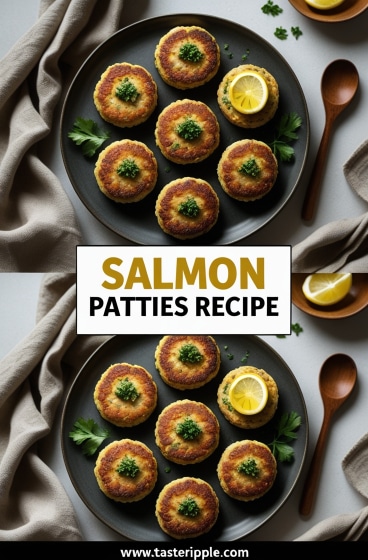You know when you’re standing in the kitchen late at night, fridge door humming, and you’ve got nothing but a can of salmon, some breadcrumbs, and a stubborn craving? That’s the moment salmon patties step in. They’re not just a recipe. They’re survival food turned gourmet, poverty cooking that somehow became Sunday brunch. My grandmother used to call them “sea burgers,” and I’ll admit—half the time they were better than the beef version. There’s just something about that crisp golden shell giving way to tender flakes of salmon inside.
Salmon patties are one of those recipes that feels old and new at the same time. They’ve been around in Southern kitchens forever, usually fried in cast iron with just enough oil to make them sing. But you’ll also see them in modern cafés, topped with microgreens and served next to a dill aioli. They adapt. They bend. They’re as humble as pantry cooking gets, yet as versatile as any fine dining fish cake. That’s the magic.
What makes them special? Simplicity. A handful of ingredients—fish, binder, seasoning—and the promise of something hot and crispy in minutes. And unlike crab cakes that demand fresh lump crab and delicate handling, salmon patties welcome both canned and fresh fish. They’re democratic, forgiving, even playful. Let’s go deep into what makes a proper salmon patty sing, from ingredient science to crisping technique.
Ingredients and Substitutions
The base formula is straightforward: salmon, binder, seasoning, fat. But each of those has choices, and every choice changes the end result just a bit. Professionals know that details here matter.
Core Ingredients
Here’s the essential list, with suggested quantities for about 8 medium patties.
| Ingredient | Amount | Notes & Substitutions |
|---|---|---|
| Salmon (canned, drained, or cooked fresh) | 14 oz (about 2 cups) | Canned pink or sockeye for convenience. Freshly cooked fillet for richer flavor. |
| Egg | 1 large | Binds mixture. Can sub flax egg (1 tbsp ground flax + 3 tbsp water) for vegan version. |
| Breadcrumbs | 1/2 cup | Panko for lightness, regular for dense. Can use almond flour for low-carb. |
| Onion (finely diced) | 1/4 cup | Adds sweetness and moisture. Shallots or scallions work too. |
| Fresh parsley | 2 tbsp, chopped | Adds freshness. Dill or cilantro also fit, depending on cuisine. |
| Lemon juice | 1 tbsp | Brightens flavor. Lime works, or even a splash of vinegar. |
| Salt | 1 tsp | Adjust to taste. If using canned salmon with bones/skin, reduce slightly. |
| Black pepper | 1/2 tsp | Freshly ground always better. White pepper if you want it mild. |
| Olive oil or neutral frying oil | 3 tbsp | For pan frying. Butter-oil mix adds nutty richness. |
Now, some cooks sneak in extras—grated carrot for sweetness, hot sauce for heat, or Old Bay for that East Coast seafood vibe. That’s the joy. Salmon patties don’t complain when you improvise.
Ingredient Insights
Fresh vs. canned salmon is always the debate. Fresh fillets give you a cleaner, less “fishy” taste and a delicate flake. But canned sockeye brings intensity and nostalgia, plus calcium if you leave in the soft bones. It’s pantry-ready too. For pros, fresh is the choice for refined plating. For home kitchens, canned is unbeatable for convenience.
Breadcrumb choice shifts texture drastically. Panko keeps patties airy, while crushed saltines make them denser and old-fashioned. Almond flour or oat flour makes them gluten-free but also adds nuttiness. Even mashed potatoes can stand in if you’re short on crumbs—giving them a softer, croquette-like feel.
Egg is the glue, but some chefs skip it altogether if the salmon is fatty enough. Vegan binders like flax or chia seeds work, though they change the texture slightly—more earthy, less springy.
Step-by-Step Instructions
Step 1 – Prep the Salmon
Drain your canned salmon well, but don’t rinse. Rinsing washes away flavor. If using fresh, cook the fillet first—poach, steam, or bake until just done, then flake. Avoid overcooking; dry salmon leads to dry patties. Tiny bones in canned salmon? Mash them in. They’re soft, edible, and add calcium.
Step 2 – Mix the Base
In a large bowl, combine salmon, egg, breadcrumbs, onion, parsley, lemon juice, salt, and pepper. Mix gently with a fork. Don’t mash it to paste; you want little flakes intact. A common mistake is overmixing—this gives dense, heavy patties instead of tender ones.
Step 3 – Shape the Patties
Scoop about 1/3 cup of mixture and form into discs about 3/4 inch thick. Too thin and they’ll dry out, too thick and they won’t cook evenly. If the mixture feels loose, add more crumbs. If it’s dry, a spoonful of mayo or yogurt helps bind. Chill shaped patties in the fridge for 20 minutes—this firms them up and reduces breakage during frying.
Step 4 – Fry to Crisp Perfection
Heat oil in a skillet over medium heat until shimmering. Lay patties in gently, don’t crowd. Fry 3–4 minutes per side until golden brown and crisp. The key is patience: don’t flip too soon, or they’ll crumble. Wait until edges are deeply browned and the bottom has set. A thin metal spatula is best for clean flips.
Step 5 – Rest and Serve
Transfer patties to a paper-towel-lined plate. Letting them rest 2–3 minutes keeps the crust intact. Serve hot, with lemon wedges or a creamy sauce.
Variations and Twists
For spice lovers: fold in a teaspoon of cayenne or minced jalapeño.
For Mediterranean flair: swap parsley for dill, add capers, and a dollop of Greek yogurt.
For Southern style: use cornmeal instead of breadcrumbs and fry in bacon fat.
Cooking Techniques and Science
Why do salmon patties sometimes fall apart? It’s about protein structure. Salmon alone doesn’t bind tightly once flaked. The egg adds protein that sets during cooking, acting like edible glue. The breadcrumbs absorb moisture, swell, and hold it all together. Miss either of those, and you’re chasing broken bits around the skillet.
The frying stage is another science moment. At around 300–350°F, Maillard reaction kicks in—the browning that creates deep flavor and aroma. Too hot, and the crust burns before the inside warms. Too cool, and the patties soak up oil like sponges. That’s why medium heat is gold.
Tools Matter
Cast iron is king for frying patties. It holds steady heat, giving even browning and less sticking. A nonstick pan works too, but it won’t build the same crust. Stainless steel can be tricky unless you preheat well and use enough oil.
Storage and Reheating
Cooked patties keep 3 days in the fridge, sealed tight. To reheat, skip the microwave—it turns them soggy. Instead, crisp them in a skillet with a splash of oil for 2–3 minutes per side. Or bake at 375°F for 10 minutes. They also freeze well: cool, wrap individually, and freeze up to 2 months. Reheat straight from frozen in the oven.
Substitutions and Dietary Versions
Gluten-free? Almond flour or ground oats instead of breadcrumbs.
Low-carb? Crushed pork rinds give crunch without carbs.
Dairy-free? Skip any mayo additions and use olive oil for richness.
Vegan? Use mashed chickpeas or jackfruit instead of salmon, plus flax egg binder. The result isn’t salmony, but still makes a tasty “patty.”
Serving and Pairing Suggestions
Salmon patties beg for contrast—crispy exterior, creamy or tangy accompaniments. A classic is tartar sauce or lemony mayo. For freshness, pile on a cucumber-dill salad or slaw. They also sit beautifully on a bun, turning into salmon burgers with lettuce and tomato.
For a plated dinner, pair with roasted potatoes and steamed green beans. Or tuck them into pita with tzatziki and greens. A drizzle of hot honey over the top? Absolutely transforms them.
Drink pairings lean crisp and light. A Sauvignon Blanc with citrus notes mirrors the lemon in the patties. A pilsner or wheat beer works too, cutting through the richness. For non-alcoholic, sparkling water with cucumber slices feels just right.
Best Time to Serve
Honestly, salmon patties don’t need a schedule. They’re weekday dinner champions because they come together in under 30 minutes. They’re also brunch-worthy—stack two patties on toast with poached eggs and hollandaise, like a seafood spin on eggs Benedict. Cold leftovers in a sandwich make for the kind of lunch that feels like you actually planned ahead. Late night? That’s when they shine most, hot from the skillet with nothing but lemon juice squeezed over.
Conclusion
What makes salmon patties eternal is their balance of ease and satisfaction. You can make them with pantry staples or dress them up with fresh herbs and aioli. They thrive in cast iron, they forgive substitutions, and they reward even sloppy cooks with something edible. For chefs, they’re a study in binding, frying, and flavor balance. For everyone else, they’re just darn good comfort food.
The tips to remember: don’t overmix, don’t flip too soon, and don’t fear canned salmon. Play with herbs, play with crumbs, and let the patties tell their own story. Crisp, tender, lemony, nostalgic—that’s the essence.
FAQs
Can I bake salmon patties instead of frying?
Yes, bake at 400°F for about 15–18 minutes, flipping halfway. They won’t be as crispy as fried but still tasty.
Why are my salmon patties falling apart?
Usually not enough binder. Add more egg or breadcrumbs, and chill before cooking.
Can I use raw salmon instead of cooked?
Yes. Chop raw salmon finely, mix with seasonings, and pan fry. The texture is more like a salmon burger, less flaky.
What sauces go best with salmon patties?
Tartar, remoulade, lemon-dill yogurt, or spicy sriracha mayo are all fantastic choices.
Are salmon patties healthy?
Yes, especially if baked or pan-fried with minimal oil. They’re high in protein and omega-3s.

